Andrew Cartmel's Blog, page 17
January 14, 2018
Jumanji: Welcome to the Jungle by McKenna & Sommers et al
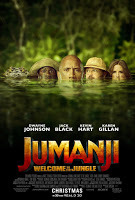 I've never seen the 1995 Robin Williams movie Jumanji. It was based on a book by Chris Van Allsburg, who also wrote The Polar Express, and had a trio of screenwriters (plus the book's author) who were credited on the script. One of these, Greg Taylor, also gets a credit on the new movie...
I've never seen the 1995 Robin Williams movie Jumanji. It was based on a book by Chris Van Allsburg, who also wrote The Polar Express, and had a trio of screenwriters (plus the book's author) who were credited on the script. One of these, Greg Taylor, also gets a credit on the new movie...This is a movie I wouldn't even have considered seeing if my friend Celeste hadn't alerted me to it.
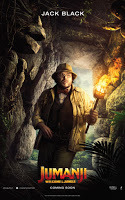 The intriguing aspect of the new film is that it involves a group of teenage kids who end up sucked into a video game in the form of avatars...
The intriguing aspect of the new film is that it involves a group of teenage kids who end up sucked into a video game in the form of avatars...So a curly haired wimp Spencer (Alex Wolff) morphs into the Rock — sorry, Dwayne Johnson — and high school jock Fridge (Ser'Darius Blain) is converted to Kevin Hart.
But, best of all, nasty hot girl Bethany (Madison Iseman) becomes a fat, bearded Jack Black and the socially awkward Martha (Morgan Turner) ends up as a Tomb Raider-esque Karen Gillan.
What ensues would just be a routine action fantasy romp, except for this body-swapping aspect. It lifts the movie to a whole other level.
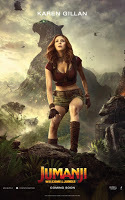 Jack Black is an absolute scream as the spoiled Bethany ('Where's my phone?') and Karen Gillan is wonderful, pretending to be uncomfortable in her body and not to know how to flirt.
Jack Black is an absolute scream as the spoiled Bethany ('Where's my phone?') and Karen Gillan is wonderful, pretending to be uncomfortable in her body and not to know how to flirt.But it all goes deeper than that. When Bethany/Jack Black meets a cute guy and falls for him, it's actually sweet and quite touching. And Karen Gillan's performance is wonderfully subtle and nuanced – I had no idea what a marvellously gifted actress she is.
 Whoever dreamt up the avatar device was a genius, because it transforms Jumanji: Welcome to the Jungle from a disposable piece of junk to something actually quite memorable.
Whoever dreamt up the avatar device was a genius, because it transforms Jumanji: Welcome to the Jungle from a disposable piece of junk to something actually quite memorable. It's worth noting that the screenwriting team of Chris McKenna & Erik Sommers worked both on this and Spider-Man: Homecoming, another dumb title with a colon in it, and another unexpectedly good movie.
 The other writers credited on this film are Scott Rosenberg & Jeff Pinkner.
The other writers credited on this film are Scott Rosenberg & Jeff Pinkner.Jumanji: Welcome to the Jungle may not be a towering cinematic masterpiece. But it does vastly exceed all expectations.
If you're looking for a movie to take the family to, I recommend it highly.
(Image credits: A dense jungle of posters at good old Imp Awards.)
Published on January 14, 2018 02:00
January 7, 2018
One Monday We Killed Them All by John D. MacDonald
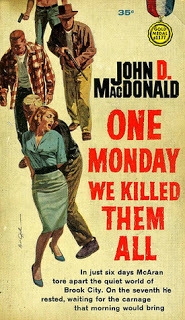 Among the many excellent suspense novels by John D. MacDonald, this is another favourite of mine. There is an amazing grim sense of foreboding and approaching doom in the book, which derives not least from the brilliant title.
Among the many excellent suspense novels by John D. MacDonald, this is another favourite of mine. There is an amazing grim sense of foreboding and approaching doom in the book, which derives not least from the brilliant title. The set up is simple and powerful. A small town cop called Fenn Hillyer has an idyllic marriage save for one small detail — his wife Meg's brother, Dwight McAran. McAran is a psychopathic thug. And he's just about to be released from prison.
And he's sworn revenge on the town where our hero lives.
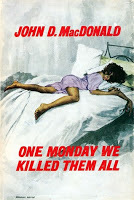 Heightening the tension is the fact that Meg utterly refuses to believe that there's anything wrong with McAran. She's protective of her little brother. So much so that, to Fenn's chagrin, she invites him to stay with them when he gets out of the slammer.
Heightening the tension is the fact that Meg utterly refuses to believe that there's anything wrong with McAran. She's protective of her little brother. So much so that, to Fenn's chagrin, she invites him to stay with them when he gets out of the slammer.Fenn reluctantly drives up to the prison to collect McAran and brings him home. As soon as they get out of the car, the big silly family dog comes bounding towards them in a frenzy of delight to offer a friendly greeting.
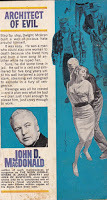 And, in one of MacDonald's most brilliant scenes, McAran responds thus: "He punched her in the chest with a quick lift of the knee... she landed a-sprawl six feet away." With "a shrill keen of spinster despair" the poor dog turns tail, flees and hides.
And, in one of MacDonald's most brilliant scenes, McAran responds thus: "He punched her in the chest with a quick lift of the knee... she landed a-sprawl six feet away." With "a shrill keen of spinster despair" the poor dog turns tail, flees and hides. "The back of my neck felt cold," says Fenn. And then his wife Meg, who has not witnessed any of this, comes racing out of the house to welcome her beloved brother.
Which is where MacDonald's unique brilliance and dark humour really show themselves: "for one nightmarish moment I had a vision of the knee lifting again... to send her, too, tumbling onto the sodden ground."
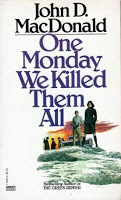 Soon the entire family except for Meg, including the kids and the dog, realise there is a psychopath in residence.
Soon the entire family except for Meg, including the kids and the dog, realise there is a psychopath in residence. Actually MacDonald — or at least his character Fenn — dismisses the term "psychopath", but he gives a pretty shrewd description of the characteristics ("considerable surface charm... impulsive and unreliable"). Fenn is content to conclude that "the quick dark shapes of his thoughts were beyond my capacity to imagine."
Meg attempts to keep things jolly, but "The unyielding presence of McCaran made it like trying to play a banjo in a crypt."

This book is close kin to MacDonald's The Executioners (filmed twice as Cape Fear) in that is shows an ordinary family on a collision course with a criminal psychopath while the hero is helpless to lawfully do anything to stop it.
Probably the most powerful engine in the story is our frustration at Meg's stubborn refusal to realise what McAran is, and the grim delight we take in the terrible inevitability of her finally seeing the truth.
 Throughout the book MacDonald's superlative powers of description are in evidence. An impulsive, spoiled young woman is "as random as the March wind." And the death rattle of a character is described as "a last sound that was like somebody trying not to cough in church."
Throughout the book MacDonald's superlative powers of description are in evidence. An impulsive, spoiled young woman is "as random as the March wind." And the death rattle of a character is described as "a last sound that was like somebody trying not to cough in church."The climax, which takes us out of town and into the wilderness of the surrounding hill country, is particularly vividly evoked. Fenn looks up into the morning sky where "A hawk drifted, turning his head from side to side, his mind on a breakfast mouse."
And Fenn's grim early assessment of his own situation is entirely accurate: "there's no way to stop it. It's like a long hill and no brakes."

By the way... I committed a professional foul earlier when I said that McAran was Meg's brother. MacDonald actually made him a half brother instead of a full sibling. Which was, I think, a failure of nerve. Or perhaps it was imposed on him by a weak-kneed publisher.
That has no effect on the greatness of this beautifully written, utterly compelling, compact thriller. I know I've said it before (of The Drowner), but if you're thinking of trying John D. MacDonald, this is an ideal place to start.
 (Image credits: The covers are from Good Reads. Incidentally, the Bob McGinnis cover of the snowy landscape is bizarrely irrelevant. There isn't a flake of snow in the entire book. But then, for that matter, as far as I can tell nobody actually gets killed on Monday in the story... The magazine spread with illustrations by Thornton Utz is from Pinterest. The Danish cover — even more irrelevant than the snowscape — is from a handy site entitled John D. MacDonald Covers as is the Spanish one. The back cover art for the Gold Medal edition is from Time Machine to the Twenties.)
(Image credits: The covers are from Good Reads. Incidentally, the Bob McGinnis cover of the snowy landscape is bizarrely irrelevant. There isn't a flake of snow in the entire book. But then, for that matter, as far as I can tell nobody actually gets killed on Monday in the story... The magazine spread with illustrations by Thornton Utz is from Pinterest. The Danish cover — even more irrelevant than the snowscape — is from a handy site entitled John D. MacDonald Covers as is the Spanish one. The back cover art for the Gold Medal edition is from Time Machine to the Twenties.)
Published on January 07, 2018 02:00
December 31, 2017
Best Films of 2017
 Okay, before we get to this year's winners, let me give honourable mention to a few films that were better than they had any right to be...
Okay, before we get to this year's winners, let me give honourable mention to a few films that were better than they had any right to be...Happy Death Day was Groundhog Day recast as a slasher pic. It has a final revelation which satisfyingly ties up loose ends, and one of the finest title sequences I’ve seen.
Meanwhile Assassin’s Creed should have been a disposable piece of game-based junk but was surprisingly good. It benefited from a strong cast including Michael Fassbender and Marion Cotillard.
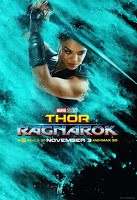 Now for a film that I felt should have been better than it was. Christopher Nolan's Dunkirk. It had great colour photography and was amazingly suspenseful. But it left me cold... cold being the operative word for Nolan's chilly brilliance.
Now for a film that I felt should have been better than it was. Christopher Nolan's Dunkirk. It had great colour photography and was amazingly suspenseful. But it left me cold... cold being the operative word for Nolan's chilly brilliance.Next, a couple of oddball contenders... Stephen Soderbergh's Logan Lucky, a Southern-fried heist movie. I loved that one of Daniel Craig's dim-witted brothers has a botched tattoo which reads 'Dangerus'.
 And The Limehouse Golem, which interwove the fascinating world of the Victorian theatre with a serial killer whodunit — and managed to pull the wool over my eyes.
And The Limehouse Golem, which interwove the fascinating world of the Victorian theatre with a serial killer whodunit — and managed to pull the wool over my eyes.The Death of Stalin was both hilarious and horrifying; I must get the graphic novel it was based on.
And Paddington 2 pulled off the difficult trick of being a family comedy without being cloying. Hugh Grant as the thespian villain rises to the occasion magnificently.
 Miss Sloane told a suspenseful tale of nefarious shenanigans in the world of Washington lobbying. It has a superlative twist at the end.
Miss Sloane told a suspenseful tale of nefarious shenanigans in the world of Washington lobbying. It has a superlative twist at the end. American Made, a tale of industrial-scale drug smuggling had an interesting, sardonic and powerful script, great direction by Doug Liman and a very appealing and cheeky performance by Tom Cruise. Terrific, harrowing fun.
And I enjoyed sf cryo-sleep drama Passengers immensely. Chris Pratt fails to resist the temptation to thaw out Jennifer Lawrence...
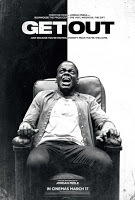 But enough of near misses. Here is my purely personal Top Ten for 2017:
But enough of near misses. Here is my purely personal Top Ten for 2017:Unlocked, a superb spy thriller written by Peter O’Brien, directed by Michael Apted and starring Noomi Rapace. In a departure from his usual roles, Orland Bloom is a revelation.
War for the Planet of the Apes. A great movie, and one which really got to me. I cared so deeply about the characters, I felt sick with fear at times. Heart rending, heart breaking, lyrical.
 Thor Ragnarok. Wonderfully funny. Tessa Thompson is unforgettable fun as a drunken Valkyrie.
Thor Ragnarok. Wonderfully funny. Tessa Thompson is unforgettable fun as a drunken Valkyrie.Star Wars The Last Jedi. After Rogue One I’d feared the worst, but this was magnificent. I'll be posting about it in detail soon.
Jackie. A biopic of Jackie Kennedy and a masterpiece. Staggeringly good, and so true to the period it’s as if they stuck a camera through a wormhole back to 1963.
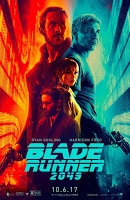 Get Out. A horror movie and a black comedy. It looks at issues of race in America through the lens of a commercial horror film. Often hilariously funny and very suspenseful, it makes amazing use of small, telling moments to generate enormous drama and fear.
Get Out. A horror movie and a black comedy. It looks at issues of race in America through the lens of a commercial horror film. Often hilariously funny and very suspenseful, it makes amazing use of small, telling moments to generate enormous drama and fear. Wonder Woman. This had to be up near the top... although Chris Pine looks uncannily like Goodman Beaver. Gal Gadot has the great line, “I’m the man who can."
 Blade Runner 2049. I loved this and what was particularly remarkable was the way it recaptured the look and feel — the essence — of the original.
Blade Runner 2049. I loved this and what was particularly remarkable was the way it recaptured the look and feel — the essence — of the original.Their Finest. You've probably never heard of this, but it is utterly wonderful and was very nearly my film of the year. A home-front WW2 romantic comedy about film makers working on a story about Dunkirk, for me this utterly eclipsed Nolan's movie. It has enormous heart and warmth, with great characters and humour. Deeply moving and beautifully crafted.
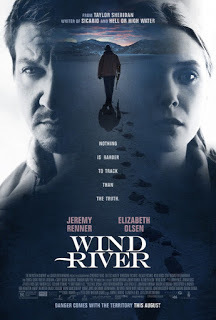
But my top pick of 2017 is Wind River. For the third year running, the best movie of the year was written by Taylor Sheridan. This time he directed it, too. It's the story of a murder on an Indian reservation, investigated by a local tracker and an out-of-her-depth big city Fed: "This isn’t the land of backup, Jane. This is the land of you’re on your own.”
(Sheridan's previous masterpieces were Sicario and Hell or High Water.)
(Image credits: Thanks to the ever reliable Imp Awards for all the posters.)
Published on December 31, 2017 04:18
December 24, 2017
The Girl with the Dragon Tattoo by Zaillian, Fincher and Larsson
 I've just been reading an excellent graphic novel based on The Girl With the Dragon Tattoo and it reminded me of David Fincher's film version, one of my favourite movies — and at the time of its release it was described as a "feel bad Christmas movie" — so it's seasonal!
I've just been reading an excellent graphic novel based on The Girl With the Dragon Tattoo and it reminded me of David Fincher's film version, one of my favourite movies — and at the time of its release it was described as a "feel bad Christmas movie" — so it's seasonal!And I regretted that I'd never posted about it before, so I thought I'd put that right now after watching the Blu-ray again (which features some very useful extras).
You may well be familiar with this material. It's based on a huge global bestselling novel by the Swedish writer Stieg Larsson. There was an earlier Swedish film of the book — it's a good film, starring Noomi Rapace in the title role of Lisbeth Salander.
 In this one we have Rooney Mara who played a small but memorable part in Fincher's Social Network. Here she is a revelation, almost unrecognisably transformed.
In this one we have Rooney Mara who played a small but memorable part in Fincher's Social Network. Here she is a revelation, almost unrecognisably transformed. Rooney Mara says of Rapace in the Swedish version: "What she did is incredible, but there was room for a completely different interpretation."
How true. Many people have the reflex reaction that the Swedish original must be better than the Hollywood remake.
Sorry, but they are simply wrong.The US version is vastly superior, and an enduring masterpiece. For a start David Fincher is, for my money, the greatest living director.

And he makes the interesting connection that the story, a dark thriller about the evil of old money, resembles Chinatown.
The movie is written by Steve Zaillian, one of the best screenwriters in the business (he won an Oscar for Schindler's List).
Zaillian boils down the appeal of the story to "The mystery... and the two characters... they're fantastic." And he has done a fantastic job himself, of adapting this big and complex novel.
 But, despite this blog concentrating on giving writers their due, I departed from tradition by putting the director's name in the title here. That's how important I think Fincher's creative contribution is.
But, despite this blog concentrating on giving writers their due, I departed from tradition by putting the director's name in the title here. That's how important I think Fincher's creative contribution is.The first crucial decision for the American version was to set it in Sweden. Fincher said, "It's a very European property. There was no way to really transpose it. You couldn't make it take place in Seattle or Montreal... although there were conversations! No, it needed to take place in Sweden. It was wholly Swedish."
 Indeed Rooney Mara says not shooting in Sweden would have been "blasphemy." And Goran Visnjic, who plays Salander's boss in the movie, makes the point that she couldn't be a ward of the court like this anywhere except in Sweden. A crucial feature of the plot.
Indeed Rooney Mara says not shooting in Sweden would have been "blasphemy." And Goran Visnjic, who plays Salander's boss in the movie, makes the point that she couldn't be a ward of the court like this anywhere except in Sweden. A crucial feature of the plot.So, a vast and world-class American movie-making machine transferred to Sweden and set to work filming in 2010.
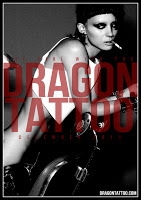
The movie begins with a remarkable title sequence, which is like a nightmare version of a James Bond title sequence. Indeed, Fincher's concept for this was to ask, "What would Lisbeth's nightmares be?"
As I've said, this is a big, complex story. But essentially it tells how disgraced journalist Mikael Blomkvist (Daniel Craig – James Bond himself) ends up licking his wounds in a lonely cottage on the estate of a tycoon who has hired him to find the killer of his niece in a crime that dates back to 1965.

Blomkvist first strikes up a friendship with a lovely local feral tabby (played by Scotty the cat). Then his isolation is further diminished when he forms a partnership with Lisbeth, a sort of wild stray cat herself — a punk computer hacker who might be somewhat autistic, or just seriously traumatised...
She's his salvation, and he is hers. Salander is like a feral child who become socialised by her friendship with (and love for) Mikkel. When they finally track down the murderer she politely asks, "May I kill him?"
She wouldn't have done that before!
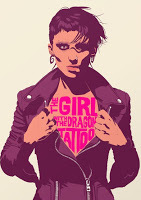
The murderer is a marvellous piece of work. He has a basement torture lair where he plays Enya while he commits his atrocities — I think this is hilarious, and also a stroke of genius which speaks to the ultimate banality of this character.
Beautifully written, directed and photographed, with a superlative cast at the top of their game (including Scotty the cat!) this is a flawless film. It was supposed to be the beginning of a franchise.
What a tremendous shame that it wasn't.
 (Image credits: Three striking official black and white posters from Imp Awards, but there's no lack of excellent unofficial poster art. The slightly explicit Samya Ghosh one is from Deviant Art. The cover of W magazine is from Pop Sugar. The superb op-art version with a similar look is by Mike Wrobel and is taken from Society 6 and you can buy copies of a print from the Mike Wrobel Shop.The poster with the scratched eyes is fron Rebloggy, which has a number of interesting designs. The motorcycle and cigarette poster is from Mikie Daniel. The nice one with the blue house is from Behance.)
(Image credits: Three striking official black and white posters from Imp Awards, but there's no lack of excellent unofficial poster art. The slightly explicit Samya Ghosh one is from Deviant Art. The cover of W magazine is from Pop Sugar. The superb op-art version with a similar look is by Mike Wrobel and is taken from Society 6 and you can buy copies of a print from the Mike Wrobel Shop.The poster with the scratched eyes is fron Rebloggy, which has a number of interesting designs. The motorcycle and cigarette poster is from Mikie Daniel. The nice one with the blue house is from Behance.)
Published on December 24, 2017 02:00
December 17, 2017
Justice League by Whedon, Terrio & Snyder
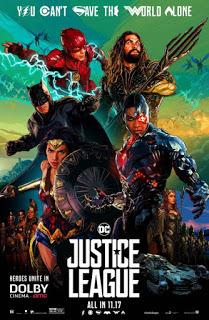 Well, I really didn't expect to be writing about this... Other than the magnificent Wonder Woman, the movies made from DC comics in recent years have been an uninspiring bunch.
Well, I really didn't expect to be writing about this... Other than the magnificent Wonder Woman, the movies made from DC comics in recent years have been an uninspiring bunch.This, it has to be said, is mostly due to Zack Snyder. I'd greatly enjoyed Snyder's work on Dawn of the Dead and, indeed, Watchmen (the greatest DC comic of them all).
However, as gifted as he is, his movies tend towards empty spectacle, to say the least (see, or rather don't see, Sucker Punch).
 So the recent Superman and Batman franchises, as presided over by Snyder, have wildly missed the mark. But not this one. Which seems to me to be due to the involvement of Joss Whedon (of Buffy and the Avengers fame).
So the recent Superman and Batman franchises, as presided over by Snyder, have wildly missed the mark. But not this one. Which seems to me to be due to the involvement of Joss Whedon (of Buffy and the Avengers fame).The reason Zack Snyder's work fails is because he has no gift for characterisation, or at least no interest in it. His stuff is cold.
With the result that his DC movies have been glum, joyless slug-fests. It doesn't matter how great your action sequences are if the audience isn't engaged with the characters. (Superman v Batman was a classic example of this.)
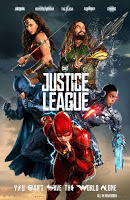 But when Joss Whedon enters the equation, all that changes. Whedon is all about characterisation, and fun. He brings warmth and humour.
But when Joss Whedon enters the equation, all that changes. Whedon is all about characterisation, and fun. He brings warmth and humour. Joss Whedon co-wrote the script for Justice League (with Chris Terrio, who won an Oscar for Argo). Whedon also did some of the directing on the movie (uncredited) after Zack Snyder suffered a terrible family tragedy.
The entwining of Joss Whedon and Zack Snyder's sensibilities is perfect. Whedon brings the characters to life so we care about them and their fate. So when Snyder mounts one of his action sequences they work. Indeed, they almost blow your head off.
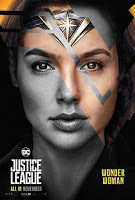 Justice League's cast is well chosen. The divine Gal Gadot is back as Wonder Woman, and every time she smiles the screen lights up.
Justice League's cast is well chosen. The divine Gal Gadot is back as Wonder Woman, and every time she smiles the screen lights up. Jason Momoa (who played Conan in the recent big screen reboot and was Daenerys's barbarian squeeze on Game of Thrones) is effective as Aquaman — if ever there was a character who could have gone wrong, this was it. But he's successfully been reimagined for the big screen. (Although he gets teased a lot. "Do you really talk to fish?")
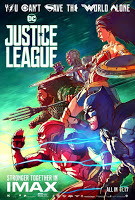 Indeed, more successfully reimagined than Cyborg. But even this dud of a character works here, thanks to the acting of Ray Fisher and the writing of Whedon and Terrio.
Indeed, more successfully reimagined than Cyborg. But even this dud of a character works here, thanks to the acting of Ray Fisher and the writing of Whedon and Terrio.Ben Affleck as Batman and Henry Cavill as Superman are both back. And, for the first time, I like them. Jeremy Irons is outstandingly amusing as Alfred the Butler, who is dressed here as a particularly British kind of nerd.
 And speaking of nerds, the Flash has joined the team as portrayed by Ezra Miller, who was the incredibly evil Kevin in We Need to Talk About Kevin — a role which could hardly be more different than this one. The characterisation of the Flash matches that of the popular TV series... he's a lovable geek.
And speaking of nerds, the Flash has joined the team as portrayed by Ezra Miller, who was the incredibly evil Kevin in We Need to Talk About Kevin — a role which could hardly be more different than this one. The characterisation of the Flash matches that of the popular TV series... he's a lovable geek.In fact, the whole team is pretty lovable, including those who would normally just be grunting hunks. Thanks, I think, to Joss Whedon.
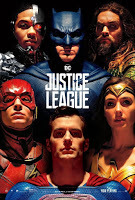 This movie isn't remotely in the league — no pun intended — of Wonder Woman. But it's way better than I anticipated; engrossing fun from start to finish, with some genuine thrills. If you like the DC universe, this may well be your cup of tea.
This movie isn't remotely in the league — no pun intended — of Wonder Woman. But it's way better than I anticipated; engrossing fun from start to finish, with some genuine thrills. If you like the DC universe, this may well be your cup of tea.Oh... and I apologise for the "spoiler" that Superman is back in this movie. But you never really believed he was dead, did you?
(Image credits: Posters are legion at Imp Awards.)
Published on December 17, 2017 02:00
December 10, 2017
Murder in the Wind by John D. MacDonald
 My survey of the work of the great American writer John D. MacDonald continues.
My survey of the work of the great American writer John D. MacDonald continues. MacDonald got his start in the pulp magazines and in some ways the title of this book is the last gasp of the pulp mentality. It would have sat happily on the contents page of any of those lurid publications.
But the book itself is vastly beyond the standards of pulp. It interweaves the narratives of a group of disparate (and sometimes desperate) characters who are thrown together when a hurricane hits Florida.
The story begins menacingly with the origins of the storm out in the Caribbean: "The flat sea had the look of a blue mirror on which warm breath had been blown, misting it." As the hurricane develops we are introduced to the protagonists.
 They are vividly and economically presented and I felt I was reading about real people until I came upon Malden, a ludicrously phony spy in a ludicrously phony spy subplot. He is described at one point as the "big man with the face of silence"; the big man with the face of bullshit, more like.
They are vividly and economically presented and I felt I was reading about real people until I came upon Malden, a ludicrously phony spy in a ludicrously phony spy subplot. He is described at one point as the "big man with the face of silence"; the big man with the face of bullshit, more like. This is the only strand that doesn't ring true. Which is odd, because MacDonald really did work in intelligence during the war. But no matter, Malden plays a tiny part in the proceedings and any weakness in his strand is buried in the general splendour of the novel.
 MacDonald's powers of observation, and his sardonic asides, are as acute as usual — "Hal turned the radio off after two bars of hillbilly anguish" — as his characters travel along the roads of Florida through "the hard roar of the rain" to rendezvous with their fate: "The miles ran fleetly under the fat wet wheels of the car."
MacDonald's powers of observation, and his sardonic asides, are as acute as usual — "Hal turned the radio off after two bars of hillbilly anguish" — as his characters travel along the roads of Florida through "the hard roar of the rain" to rendezvous with their fate: "The miles ran fleetly under the fat wet wheels of the car."But it is in his account of the hurricane itself where MacDonald truly excels. The various travellers meet when they come to a blocked bridge and can go no further, and they're forced to take refuge in an abandoned house.
Here he describes the "the claw and tug and pull of the wind" as they fight their way towards it, the "small wild sounds, fill of a supersonic shrillness" in the empty rooms. Once inside, there's still no true safety. "A great hand pushed against the house."

And there is the "odd thudding sound that was making the whole house tremble" like "a home built near the tracks of a railroad where a train went endlessly by."
The wind almost becomes a character in its own right — "this monstrous roaring thing." "Within the constant screaming he could hear various soft lost sounds—thumpings and crashings and flappings as though outside there was some great sad imprisoned animal that fought dully for release." There is "a deep note in the heart of it like the constant bowing of a string on a bass."
 Because the hurricane coincides with a high tide, there is enormous flooding. One of our protagonists feels "the Gulf was coming in after him." And their ramshackle shelter floods and fills... "When the house shook the tremor of the walls made ripples that met in the middle of the room. In the faint light the water looked black, oily."
Because the hurricane coincides with a high tide, there is enormous flooding. One of our protagonists feels "the Gulf was coming in after him." And their ramshackle shelter floods and fills... "When the house shook the tremor of the walls made ripples that met in the middle of the room. In the faint light the water looked black, oily."The story culminates when some violent young thugs among our group of refugees decide that it is the perfect moment to commit robbery at knife point.
This act of deliberate human violence in the heart of the hurricane is particularly ugly and disturbing and effective (quite unlike that bit in the movie Titanic when they're racing around fighting over the diamonds).

The robbery attempt goes horribly wrong, and the most hateful of the young thugs decides he's going to leave the flooded house and try and swim to safety. Powerful currents sweep him along until he manages to grab onto some trees.
He shares this precarious refuge with "two soaked miserable raccoons" in the branches above him. But the murderous thug gets what's coming to him. The roots of one of the trees gives way and it traps his leg against the trunk of the other one, as the water continues to inexorably rise...
"The trees were as unmovable as pillars of concrete" — MacDonald gets the meaning into the reader's brain with perfect precision. And the thug drowns...
 "When both trees went slowly down together, he was released and the current moved the body inland. The two raccoons swam sturdily towards other refuge, eyes alert in the bandit face."
"When both trees went slowly down together, he was released and the current moved the body inland. The two raccoons swam sturdily towards other refuge, eyes alert in the bandit face." John D. MacDonald is an astonishingly good writer. He is so good he makes me quietly smile and put the book down and write notes for this post.
(Image credits: These are all scanned from my own library — the Dell with the George Gross cover art, the Dell with the Bob Abbett art and the blue Fawcett with the Bob McGinnis art — except for the green Fawcett edition with the Bob McGinnis art which is from Good Reads.)
Published on December 10, 2017 02:00
December 3, 2017
Murder on the Orient Express by Green and Christie
 Like a temperamental old locomotive restored and overhauled, this year's Murder on the Orient Express is hesitant, shaky and slow to get going.
Like a temperamental old locomotive restored and overhauled, this year's Murder on the Orient Express is hesitant, shaky and slow to get going. But once it's in motion it begins to perform gratifyingly... and it definitely gets us to our desired destination.
Based on a classic mystery novel by Agatha Christie, the story has already been adapted into an excellent film back in 1974, directed by Sidney Lumet, with a script by Paul Dehn, the backbone of the first Planet of the Apes franchise, and Anthony Shaffer, who wrote Sleuth.
 This version is directed by Kenneth Branagh (who also plays Christie's hero, the detective Hercules Poirot) and has a script by Michael Green.
This version is directed by Kenneth Branagh (who also plays Christie's hero, the detective Hercules Poirot) and has a script by Michael Green. Green is an interesting writer, with extensive television experience and some recent high profile feature film credits. He was involved in both the terrible Alien: Covenant and the wonderful Blade Runner 2049.
Michael Green has made a number of changes to the original. The new movie begins with Poirot swiftly solving a high profile case — a sort of mystery in miniature — in Jerusalem. This isn't a bad idea, setting up the detective hero and his shtick at the outset of the film. I just felt it was done rather clumsily.
 And Poirot has been given a trusty cane which he wields for numerous purposes. This heightens his resemblance to a comic book super hero with his gimmick and a set of "super powers" which are set up by that mini story at the beginning.
And Poirot has been given a trusty cane which he wields for numerous purposes. This heightens his resemblance to a comic book super hero with his gimmick and a set of "super powers" which are set up by that mini story at the beginning.He's also been given an obsession with symmetry which seems utterly irrelevant until the end of the film when the detective has to decide — in a surprisingly moving scene — if he can allow the scales of justice to tilt to one side.
Green's script is often funny — there's a startling early scene with a cheerfully unabashed prostitute and her client — and he has the good sense not to mess too much with the essential Agatha Christie plot, which is very clever and which I have no intention of spoiling by revealing here.
 The movie is produced, but not directed, by Ridley Scott, and although I am often harsh in my judgements on Scott, there is no question about his astonishing visual ability as a film maker. I rather missed his presence at the helm on several occasions here — I doubt he would have sanctioned the cheesy and unconvincing CGI (for example, of period Istanbul).
The movie is produced, but not directed, by Ridley Scott, and although I am often harsh in my judgements on Scott, there is no question about his astonishing visual ability as a film maker. I rather missed his presence at the helm on several occasions here — I doubt he would have sanctioned the cheesy and unconvincing CGI (for example, of period Istanbul).And Branagh isn't great at staging action. There were some incidents when I couldn't even tell what was going on, and one long tracking shot just didn't work for me (we're outside the train looking in, so having the dialogue from inside play over the scene felt rather odd).
 But where Branagh really scores is as a magnificent director of actors, and he has assembled a superb cast of them here. They're not the big names, either. Josh Gad plays a flunky to Johnny Depp's gangster. I'd never heard of Gad before, but he has a monologue in the movie which is so superbly performed that it should be screened in every acting school in the world.
But where Branagh really scores is as a magnificent director of actors, and he has assembled a superb cast of them here. They're not the big names, either. Josh Gad plays a flunky to Johnny Depp's gangster. I'd never heard of Gad before, but he has a monologue in the movie which is so superbly performed that it should be screened in every acting school in the world.Daisy Ridley impresses, as well, showing how far her range extends beyond the Star Wars franchise (in which she was great, incidentally). But again I was knocked out by a less well known name — Lucy Boynton. She plays a drug addicted countess here and she only has one brief monologue, but it's searingly vivid and convincing.
 An amazing cast, and Branagh has drawn the best out of them. His Poirot moustache is truly horrid, but then that's sort of essential for the character. And Green's script cleverly makes reference to other classic Christie Poirot cases. At the end, the detective sets off to begin the next investigation...
An amazing cast, and Branagh has drawn the best out of them. His Poirot moustache is truly horrid, but then that's sort of essential for the character. And Green's script cleverly makes reference to other classic Christie Poirot cases. At the end, the detective sets off to begin the next investigation...And for once the prospect of a sequel is entirely welcome. Here's hoping Branagh and Green will have Hercules Poirot back on our screens soon.
(Image credits: No shortage of suspects at Imp Awards.)
Published on December 03, 2017 02:00
November 26, 2017
Ending Up by Kingsley Amis
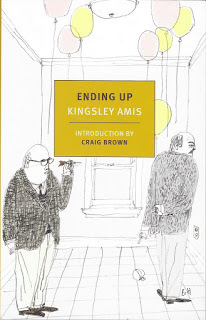 Kingsley Amis was one of the most gifted of British novelists and he remains a firm favourite of mine. His career began with the resounding success of the riotous Lucky Jim in 1954.
Kingsley Amis was one of the most gifted of British novelists and he remains a firm favourite of mine. His career began with the resounding success of the riotous Lucky Jim in 1954.Ending Up comes from 20 years later and has a very different mood to it. Lucky Jim was bright, optimistic, fizzing with energy and all about beginnings — setting off on the adventure of adult life.
As the title suggests, Ending Up is at the other end of things. It's about a collection of oldsters (a classic Amis term) who share a rather shambolic house called Tuppenny-hapenny Cottage where they are going to finish their confused, cantankerous, careworn days together.
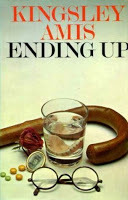 This may sound like boring or depressing material but in fact the book is addictively, effortlessly readable and grips like a thriller.
This may sound like boring or depressing material but in fact the book is addictively, effortlessly readable and grips like a thriller. In his excellent biography of Amis, Zachary Leader accurately describes Ending Up as "a feast of malice and ill humour, one of the best and most artfully constructed of Amis's novels."
Leader also has some interesting things to say about the real world sources of Amis's fictional characters in this book, such as his mother-in-law Kit Howard, an unlikable woman if ever there was one. Amis described walking past her room as "shooting the rapids" — like everyone else, he was scared of being called inside.
Amis was living in a house in Hertfordshire with Kit, his wife Jane, her brother Colin, and the painter Sargy Mann. At one point Jane idly wondered what it would be like if they all stayed there and grew old together... Kingsley Amis took note of the idea and Ending Up was conceived.
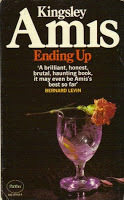 And very carefully conceived, too. Amis devised a meticulous plan for his story. which included 45 "ways to be annoying," all of which appear in the novel. He also drew floorplans of Tupenny-hapenny cottage and sketched a rudimentary timeline.
And very carefully conceived, too. Amis devised a meticulous plan for his story. which included 45 "ways to be annoying," all of which appear in the novel. He also drew floorplans of Tupenny-hapenny cottage and sketched a rudimentary timeline.But it's in his carefully drawn characters where Amis really excels. Some of them are indeed annoying, but his central figure Bernard is pure evil.
I suppose you could merely say he's a complete bastard, but I think that fatally understates the case. Bernard lives to torment the other inhabitants of the house. He is terminally ill, and knows it, but this in no way excuses his behaviour or softens the reader's attitude to him. (At least, not this reader's.)
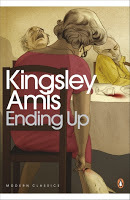 So it is a tribute to Amis's considerable talent that he actually makes us feel sympathy for Bernard towards the end of the book.
So it is a tribute to Amis's considerable talent that he actually makes us feel sympathy for Bernard towards the end of the book.But this emotional reaction was nothing compared to my utter delight when one of his evil schemes was thwarted. (Bernard was trying to deprive George, a bedridden invalid, of the beloved dog who keeps him company. I told you he was pure evil.)
Oddly, it is Marigold who foils George. I say oddly because Marigold, who was based on Kit Howard, is a dotty old racists with her own bizarre idiom (she refers to "blacks" — black people — as "blackle packles", for instance).
The other denizens of the house are the brave and resourceful George, felled by a stroke and struggling to overcome it; the alcoholic but likable Shorty and the hardworking, unappreciated and unloved Adela (a cruelly reimagined version of Amis's then wife, the distinguished novelist Elizabeth Jane Howard).
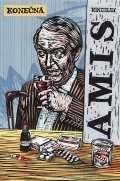 Adela is Bernard's sister and he is particularly nasty where she's concerned: "He limped off to the kitchen in confident hope of an opportunity to ridicule and distress her."
Adela is Bernard's sister and he is particularly nasty where she's concerned: "He limped off to the kitchen in confident hope of an opportunity to ridicule and distress her."In case this suggests that the book is a downer and too negative, let me quickly reassure you. It's actually hilarious, full of classic Amis moments:
"Eighteenth-century timber-frame was what she called the style of the house when asked, and sometimes when not."
"Outside the sun was shining on various items of vegetation."
" 'Yes,' said Tracy. She thought for a moment and added, 'Yes.' "
And then there's Tracy's horror at the thought of old people "fucking like a stoat at over seventy"...
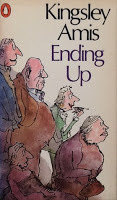 In his valuable introduction to the New York Review Books edition, Craig Dickson describes how "Throughout his oeuvre, irritation plays on the Amis landscape like sun on sea."
In his valuable introduction to the New York Review Books edition, Craig Dickson describes how "Throughout his oeuvre, irritation plays on the Amis landscape like sun on sea." There's much more here than irritation here, though, or even brilliant comedy.
The ending of the book is a breathtakingly succinct multiple tragedy in which Amis dispatches his characters in a few short pages as if a savagely avenging fate had come calling for them.
This terse, dark, hilarious little book is a masterpiece.
(I've also posted about these other novels by Kingsley Amis: That Uncertain Feeling, I Like it Here, Take a Girl Like You and The Anti-Death League.)
(Image credits: The cover of the New York Review Books edition is my scan of my own copy. The other covers — including the Czech language one featuring an image of Amis himself — are from Good Reads. Thank you, Good Reads.)
Published on November 26, 2017 02:00
November 19, 2017
Happy Death Day by Scott Lobdell
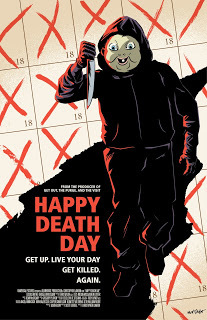 Well, this was a complete surprise... I only went to see the movie because (a) it was on at the right time to fit in with something else and (b) it was ending its run yesterday.
Well, this was a complete surprise... I only went to see the movie because (a) it was on at the right time to fit in with something else and (b) it was ending its run yesterday.And also, and I suppose crucially, because I'm always up for a horror film, in the vain hope that it might be a good one. And this was.
Basically it's Groundhog Day re-purposed as a slasher movie. Every morning our heroine Tree Gelman (played by Jessica Rothe) wakes up and lives through the same day, which culminates in her being killed by a masked assailant.
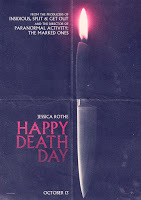 She has to work out who her killer is, and thereby break the time-loop and resume her life. This is a perfectly workable premise for a horror movie, indeed it's a pretty nifty one. It's only demerit is that it's such a clear ripoff of Groundhog Day.
She has to work out who her killer is, and thereby break the time-loop and resume her life. This is a perfectly workable premise for a horror movie, indeed it's a pretty nifty one. It's only demerit is that it's such a clear ripoff of Groundhog Day.But it gets around this, and garners lots of brownie points, by openly acknowledging the influence ("You've never seen Groundhog Day?").
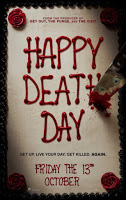 I also really liked it because it has a story twist which was both unexpected and satisfying — tying up a bunch of loose-ends in the plot which I thought they were going to leave dangling.
I also really liked it because it has a story twist which was both unexpected and satisfying — tying up a bunch of loose-ends in the plot which I thought they were going to leave dangling. Jessica Rothe is terrific. At first I didn't like her, but I was just making the rookie error of confusing the actress with the character she played. Tree Gelman is very unlikable, and Rothe does a great job of making this believable.
But as Tree's plight continues, her behaviour changes, and we warm to her — and Rothe gets to demonstrate the range of her talent.
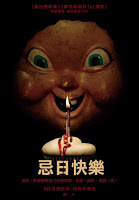
The movie is written by Scott Lobdell who has a background in scripting Marvel comics, and TV animation series. He's done an excellent job here as has the director, Christopher Landon, who's done a lot of work (as a writer as well as a director) on the Paranormal Activity series.
These guys have come up with a very clever device: the movie is set at Bayview University (actually Loyola, New Orleans) and the football team is called the "Bayview Babies" and fans wear these cartoon baby-face masks.
The killer adopts one of these, and it's mega-creepy.
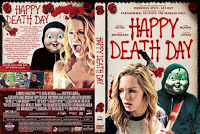 The movie has its flaws. I mean, it's set in America, so all Tree has to do to defeat her killer is go down to the nearest gun shop and buy an assault rifle with her credit card and blow him to hell... but I'm willing to suspend my disbelief here.
The movie has its flaws. I mean, it's set in America, so all Tree has to do to defeat her killer is go down to the nearest gun shop and buy an assault rifle with her credit card and blow him to hell... but I'm willing to suspend my disbelief here.Because it's an imaginative, fun little movie. And it has the best title sequence I've seen in a long time (which plays at the end of the film).
If you're a fan of horror movies, especially ones with an element of comedy, then I think you'll enjoy this. I'm only sorry I didn't see it in time to recommend it for Halloween.
 (Image credits: Not a happy day at Imp Awards, where I could only find two posters, the birthday cake and the baby mask with the cupcake and candle. So I had to ransack for the excellent black and white portrait of Jessica Rothe by Jan-Willem Dikkers. And then I found the rather nice comic-art style poster by Matt Robot is from Poster Spy. The nice knife = candle one by Alex CPS is also from Poster Spy. I think both these Poster Spy efforts are better than the official one. The DVD cover, which I think is also unofficial is from Cover City.)
(Image credits: Not a happy day at Imp Awards, where I could only find two posters, the birthday cake and the baby mask with the cupcake and candle. So I had to ransack for the excellent black and white portrait of Jessica Rothe by Jan-Willem Dikkers. And then I found the rather nice comic-art style poster by Matt Robot is from Poster Spy. The nice knife = candle one by Alex CPS is also from Poster Spy. I think both these Poster Spy efforts are better than the official one. The DVD cover, which I think is also unofficial is from Cover City.)
Published on November 19, 2017 02:00
November 12, 2017
The Snow Man by Straughan, Nesbø et al
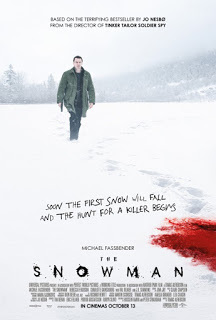 I've heard a number of interviews with Jo Nesbø and he's a smart, funny guy and clearly very talented. Having had one successful career as a rock musician, he commenced another one as a massively bestselling novelist.
I've heard a number of interviews with Jo Nesbø and he's a smart, funny guy and clearly very talented. Having had one successful career as a rock musician, he commenced another one as a massively bestselling novelist.But (and you knew there was a but coming...) I read his novel The Snowman and felt I'd wasted my time. The book features Harry Hole, a cliché embittered alcoholic cop with a trail of broken relationships, and pits him against a cliché sub-Thomas Harris serial killer.
I remember thinking that if I was going to read police procedurals I would have been a lot better off working my way through the writing of George Simenon, who is a genuine artist.
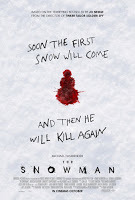 But poor novels often make excellent movies. And when I learned that The Snowman was to be directed by Tomas Alfredson, I had high hopes. Alfredson made Tinker Tailor Soldier Spy, one of my favourite films of all time.
But poor novels often make excellent movies. And when I learned that The Snowman was to be directed by Tomas Alfredson, I had high hopes. Alfredson made Tinker Tailor Soldier Spy, one of my favourite films of all time.And he is an extraordinary film maker, attacking every scene with the intention of deepening its emotional impact and its meaning and elevating it to art. Alfredson clearly cares profoundly about creating real characters and a unique atmosphere to his films, instilling every shot with poetry.
But here his talent is utterly wasted. The movie looks great, with ravishing photography by Dion Beebe (Edge of Tomorrow), superbly effective music by Marco Beltrami and a fresh and interesting cast led by Michael Fassbender, looking great but smoking rather too much as Harry Hole.
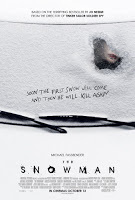 But the problem is the script. The team of writers here is impressive, too. It's led by Peter Straughan who worked on Tinker, Tailor and recently adapted Hilary Mantel's Wolf Hall for BBC Television. Also involved was Hossein Amini who recently did a fine job on Our Kind of Traitor (another John le Carré adaptation), and Søren Sveistrup, who created the Nordic noir classic TV serial The Killing.
But the problem is the script. The team of writers here is impressive, too. It's led by Peter Straughan who worked on Tinker, Tailor and recently adapted Hilary Mantel's Wolf Hall for BBC Television. Also involved was Hossein Amini who recently did a fine job on Our Kind of Traitor (another John le Carré adaptation), and Søren Sveistrup, who created the Nordic noir classic TV serial The Killing.So, a talented team. And they have radically altered the original novel, in much the same way that Scott Frank altered Lawrence Block's Walk Among the Tombstones — and with equally little success.
The story is now often quite different from the book. It's bloody complicated, but it still doesn't work. And there are some ridiculous failings in the script. For a start, Harry is ineffectual and unlikable.
And we're supposed to be emotionally invested in — wait for it — Harry's ex-girlfriend's teenage son. Seriously.
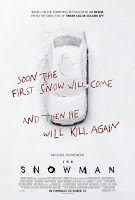 The movie puts this kid into peril and expects us to be on the edge of our seats. But there's worse to come...
The movie puts this kid into peril and expects us to be on the edge of our seats. But there's worse to come...At the very end of the film the bad guy is dealt with in a deus ex machina fashion — he falls through thin ice into a freezing lake, while our hero looks helplessly on.
Come on chaps — this violates one of the cardinal commandments of screenwriting: "Thou shalt not take the resolution out of the hands of your hero."
Before that there's a final fight between Harry and the bad guy, the latter wielding a kind of electronic garrotte device which has to be the least useful and least frightening weapon ever devised for close quarters combat.
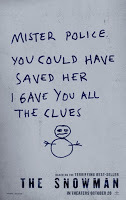 And here Alfredson has to take some of the blame, too, because this fight is so confusingly shot that we have no idea that Harry gets his finger chopped off, presumably by the silly garrotte machine.
And here Alfredson has to take some of the blame, too, because this fight is so confusingly shot that we have no idea that Harry gets his finger chopped off, presumably by the silly garrotte machine.This is only made clear in a coda in which, ridiculously, Harry is seen tapping a coffee cup with his new metal finger as he volunteers for a new case against another harrowing psycho killer.
But don't worry. That sequel won't be coming your way any time soon.
(Image credits: not exactly a blizzard of posters, courtesy of Imp Awards.)
Published on November 12, 2017 02:00



